With snowshoes you can hike anywhere in snow-covered landscapes, and the technique only takes a few minutes to learn. In this article we share our experience of hiking in snowshoes in the Austrian Alps – plus tips on things you need to know before going.
Written by Mette / Photo by Martin
The article has been published in Spejder Sports Magazine, 2019
Translated from Danish
The higher up we get, the more the valley below us looks like an idyllic Christmas card. A peaceful ascent in a cable car leaves a pleasant view of the snow-capped mountain tops – setting the stage for today’s snowshoe hike.
In a steep and gliding movement, we rise to 1,000 meters in just a few minutes. From the small village of Waidring and up to the mountain of Steinplatte with its 1,869 meters. An area that is part of the popular skiing area Kitzbüheler Alpen in Tyrol.
“Servus,” the Austrian greeting sounds as we board the cabin. We are accompanied by several locals, all dressed in full ski uniform, with stiff boots and big helmets, and we move around a bit so there is room for all their gear. Comparatively, we feel slightly underdressed in our winter clothes, hiking boots and snowshoes in hand. But far freer.
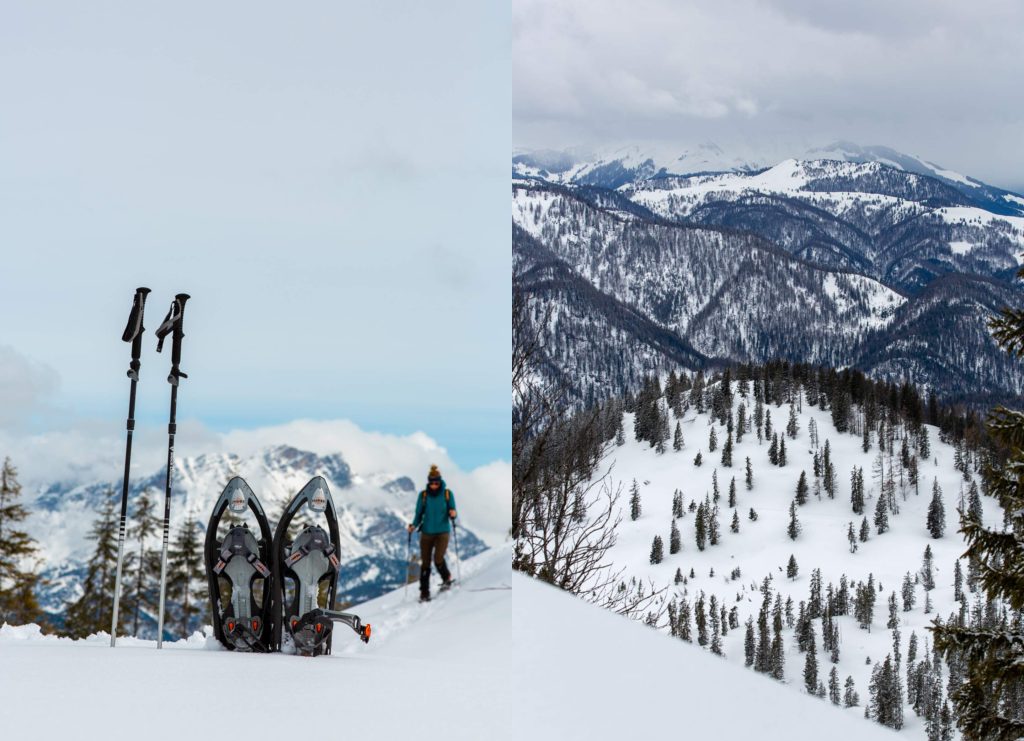
An ancient invention
When we first heard that you can go hiking during winter with snowshoes on, we had a little trouble imagining how they actually worked. Immediately we reminisced Donald Duck and the tennis racket he strapped to his feet.
Much has now changed since the world’s most famous duck trotted off in deep snow. Which, by the way, he did in the footsteps of history. Because snowshoes are an ancient invention. The oldest snowshoe that has been found is about 5800 years old and appeared not far from a mummy of the same age – frozen in a glacier on the border between Austria and Italy.
The ancient snowshoe consisted of a birch branch bent into an oval frame with strings of twine. Today, equipment is a whole science on par with skiing and is an independent sports discipline. To our surprise, you can experience snowshoe races at both world championships and arctic winter games.
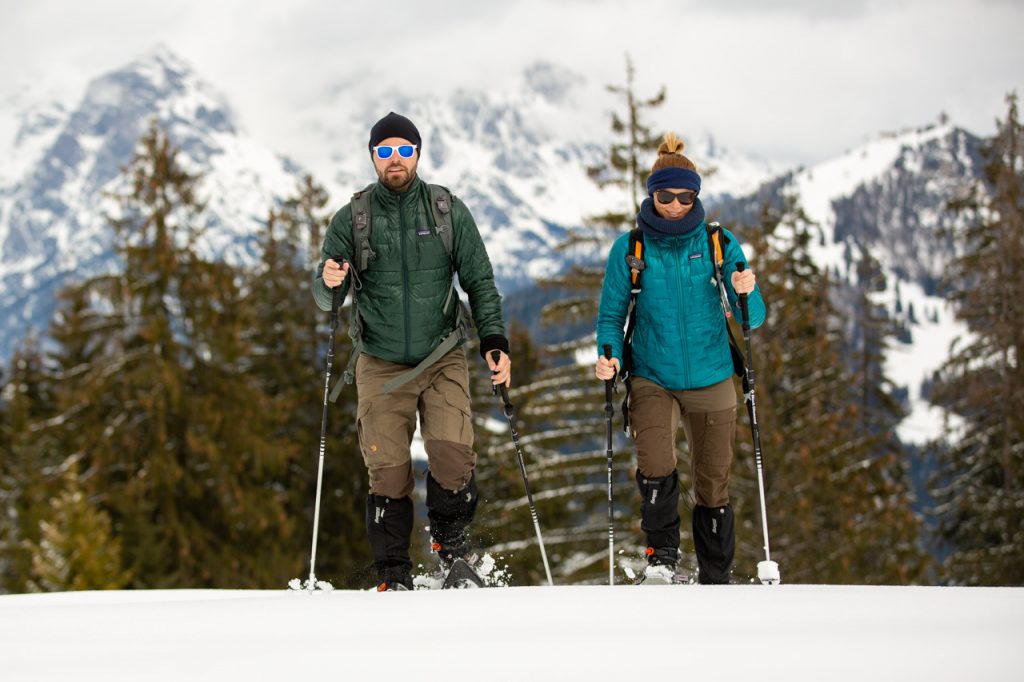
Liberating easily
However, you do not need to be an elite sportsperson to use snowshoes. On the contrary. The attractive thing about snowshoeing is that everyone can join. Snowshoes – which are not shoes, but mostly look like short, wide skis with spikes on the bottom – are neither advanced to attach nor technically difficult to use.
There are several different brands and models, and for hiking in the Alps and mountains, hard plastic snowshoes that you strap onto your boots are most common. You simply insert the toe of the boot under two straps and fasten a third behind the ankle. Much like a sandal to your bare feed. In addition, a pair of hiking poles with wide snow baskets, so they grip the surface of the snow, and you are ready for a different snow adventure.
The technique is also easy to learn. “Step a little wider, and walk normally”, our guide Lisa Flatscher instructed, as we took a few test steps on the first day of our trip. At first, it felt a bit awkward – like walking with giant flip-flops strapped to your boots. But after a few minutes, we stopped thinking about the snowshoes. Austria’s beautiful winter landscape stole all the attention.
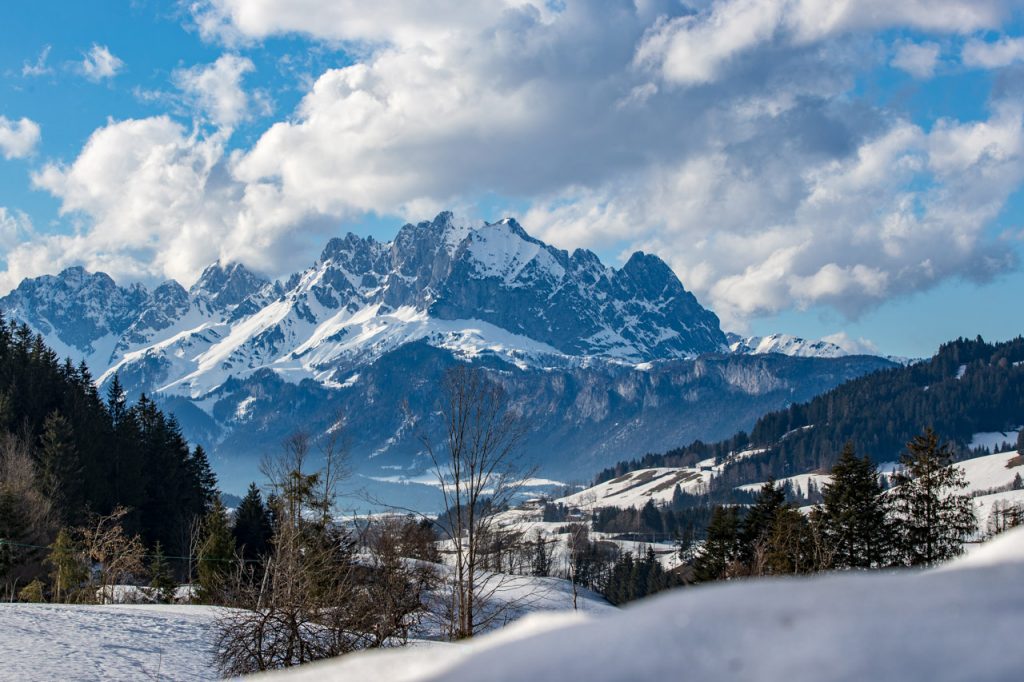
Off-piste on snowshoes
Back on the Steinplatte mountain, we have unboarded the cable car and are ready to embark on the third day of our snowshoe hike. We quickly strap on our snowshoes and quickly passed the other tourists on skis. In the last few days, we have become familiar with the equipment, and our confidence is not diminished by the fact that we are walking in Lisa’s footsteps.
Lisa grew up at Waidring, is a trained mountain guide, and organizes hiking trips in both summer and winter. Her tan reveals that she spends more time outside than inside, and we find her navigating skills in the mountains supreme. Fortunately! Because after a few minutes we turn off the piste and out into an untouched landscape covered by close to two meters of snow.
Everything is white. There are no markings here. No man-made tracks before ours. And we have no idea what we are walking on top of. Step by step, we move further and further out into a terrain that neither skis, snowboards nor snowmobiles can reach. We are completely alone, and the feeling of being the first to step on the crisp snow is magical.
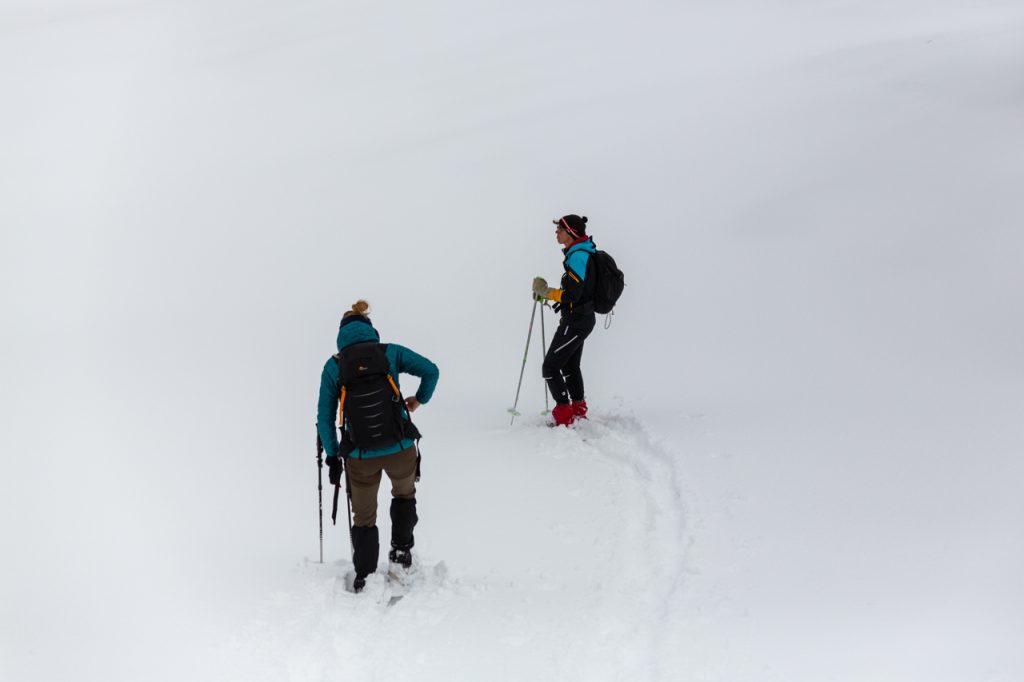
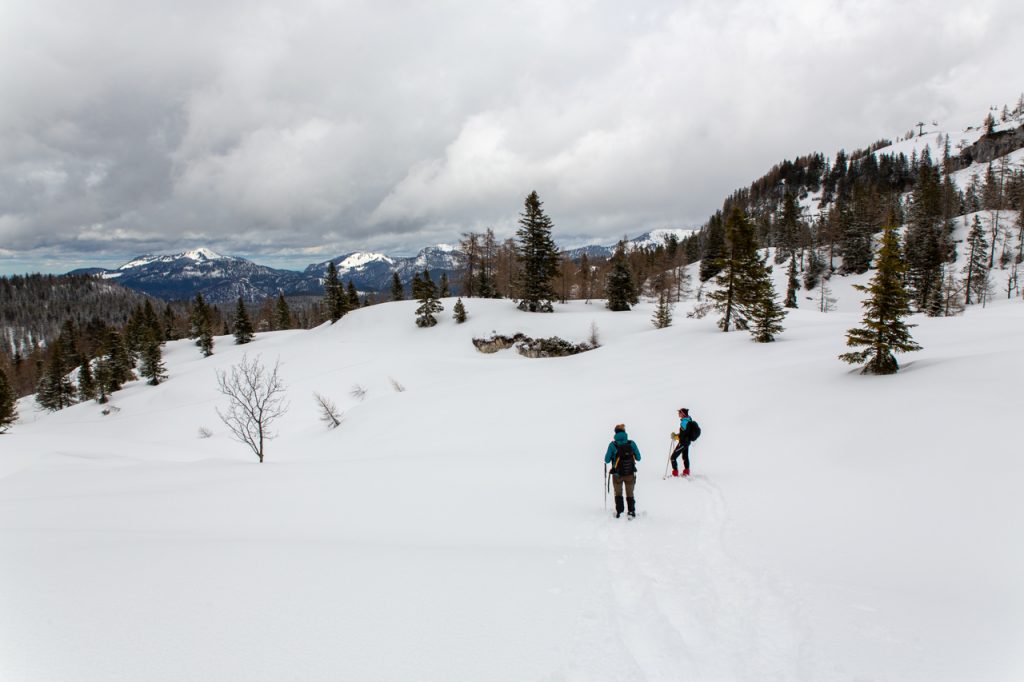
Gentle falls and easy on foot
“Kniirk, rrrrtsssj, ploouff”, it sounds every time we lift our knee, take a step, and lower our foot into the soft snow. The sound of the snowshoes is the only thing that breaks the wonderful silence. On the other hand, they are the reason why we can walk here.
We hike across open plateaus with panoramic mountain views, along dramatic rock walls that shoot vertically into the sky, and into a forest of tall conifers. In here, the wind has puffed the snow around and formed white mini-mountains between the trunks. The scenery is reminiscent of a winter landscape in Narnia, which in all its rawness is fantastically beautiful.
“PLOUUFFFF!”
With childlike enthusiasm, we let ourselves fall backward in one of the large snow drifts for fun. We sink into the snow, which wraps around the body like a fluffy quilt so that only the snowshoes stick up. In a slightly clumsy manner, we return to the vertical position and realize that it is much easier to fall than to get up.
The snowshoes stay faithfully on the boots and it is wonderful to feel how easily and effortlessly we are able to walk on top of the meter-deep snow. Without snowshoes, we had sunk in up to above our ankles. Some places much deeper. Hiking here without the snowshoes had been a very tiring experience.
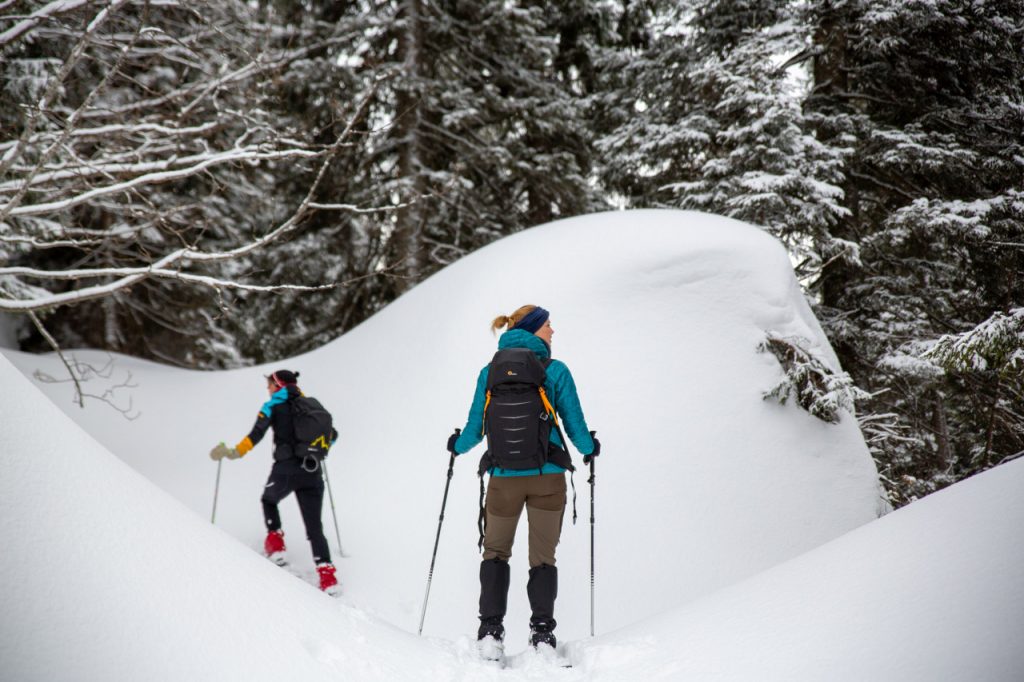
Technique tips when snowshoeing
“If you start to slide on the way down, you can tilt the rear boot toe into the snow. Then it acts as a brake”, Lisa explains, as we stand on the edge of a sloping mountainside. Although snowshoeing primarily consists of putting one foot in front of the other, there are a few tips for the technique that make it easier to traverse alpine terrain.
In addition to stepping a little wider, so that you avoid straining your legs, you must use your own weight to take advantage of the snowshoe’s grip in the snow. As you walk up, bend your knees slightly and lean your weight forward on your front foot. If the snow is slippery and icy, you can stomp hard so that the spikes dig into the ground.
If you want to go down, the weight must be on the back foot. And if it goes steeply downhill, like the hillside we’re standing at, you can do like Lisa: She takes a step over the edge and demonstrates how she half-walks and half-surfs down the mountainside with the back of her boot as rudder and brake.
“Remember to stay in your own trail of snow”, she reminds us, when it is our turn to slide down the hill. The more loose snow, the more we are slowed down. It is only when we walk on even stretches or want to save energy that it is an advantage to walk in a row and follow in the footsteps of others. A few minutes later, we are both down the mountainside without any problems. Only Mette had to sit on her bum once. It worked excellently as both airbag and anchor.
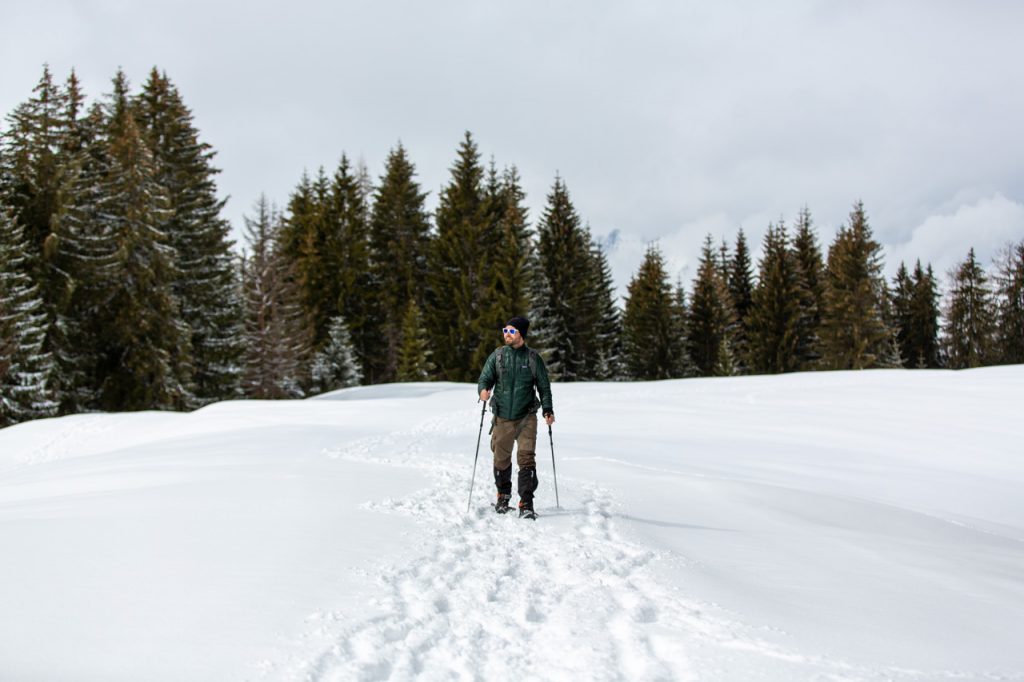
Challenges and avalanche danger
Although the snowshoes make it much easier to walk in the powdery snow, it is still good exercise. The heat spreads and the cheeks turn red, while the body works like an engine that takes us forward in the snowy mountain landscape. Step by step we fall into a common rhythm and a pace that feels completely meditative.
On the trip, we also get to try different challenges. We jump over rippling streams, climb over fallen logs, and walk up a slope so steep that we almost crawl on all fours. The grip from the snowshoes is firm, and apart from a naturally high heart rate during the efforts, we escape any problems.
We can only think of one thing that could challenge our safety: the risk of avalanches when hiking off-piste. “There is no danger here,” Lisa assures us, as we observe how our tracks create changes in the landscape. At the edge of the snowshoes, tiny snowballs are created, which roll slightly larger on the way down the slope. They draw porous lines in the loose snow.
Lisa knows the weather conditions and the area. That’s why we don’t always walk in a straight line either, as she knows what sometimes hide under the snow. Large streams, treacherous snow bridges, and other things that you cannot see with the naked eye. “Always consult with the locals if you move away from the marked routes,” her recommendation sounds.
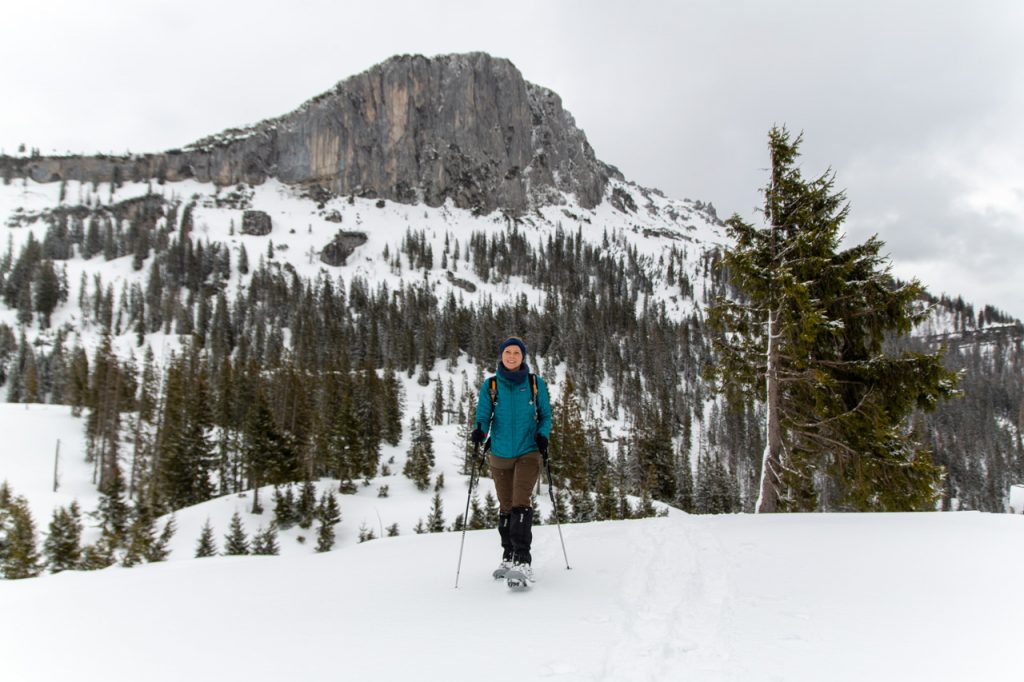
Endless view
After an hour and a half of hiking, we reach the highlight of the trip. An alpine peak in the borderland between Tyrol, Salzburg, and German Bavaria. From here, a formidable view opens up beyond deep valleys and snow-capped mountains, and on the horizon, the saw-toothed peak of the Wilder Kaiser rises like the crowning glory. On sunny days you can see all the way to Italy.
Small, soft snowflakes begin to fall from the sky and melt when they land on the clothes. The temperature is around zero degrees. It is not cold, but when the wind appears, it bites the cheeks, and the snowflakes sting. “It’s time for tea,” Lisa suggests. We seek shelter by a cluster of conifers, and Lisa pulls out a thermos and three cups from her rucksack.
The snowstorm doesn’t seem to be letting up, and the wind is increasing, so after the tea break, we quickly get going again to keep our bodies warm. We hike along the ridge for a while and occasionally have to stop to enjoy the view. The silence and beauty are soothing for all the senses. Only when we approach the piste a little later, from where the trip began three hours earlier, do we begin to feel the presence of other people.
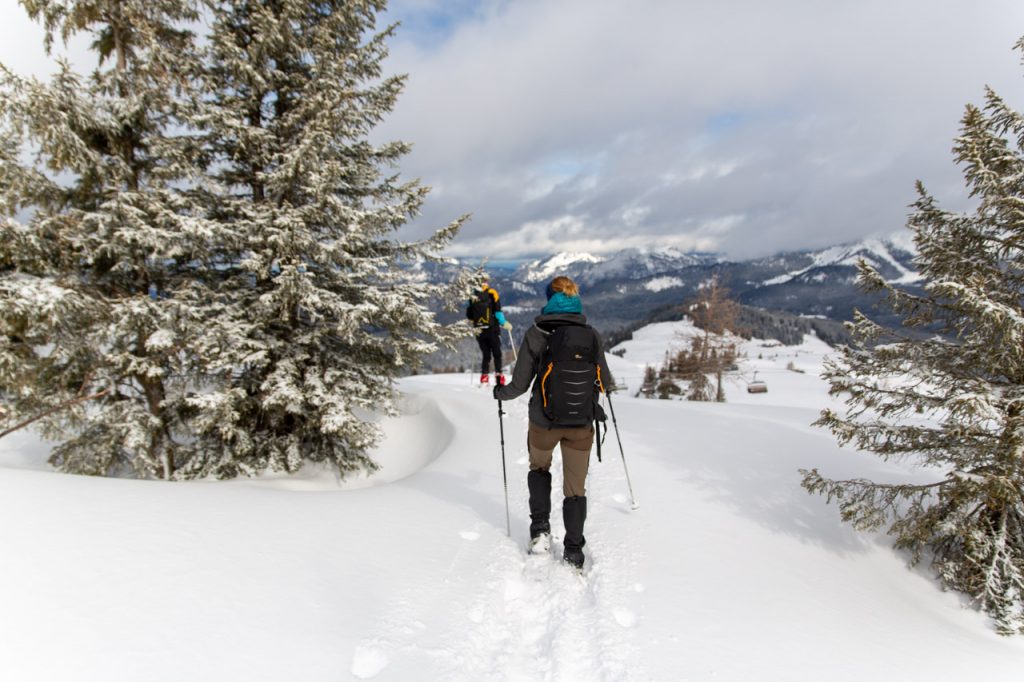
Winter adventure in sight
As we sit in the cable car again, we can look back on a hike in an unspoiled winter landscape. Literally. We can actually look down at our own tracks, which appear as dark blue lines in the white snow.
If the weather had been better, we could easily have taken a packed lunch in the rucksack and enjoyed a full-day snowshoe trip. Fortunately, tomorrow is a new day, and Kitzbühel has many more Alps that call out to be explored on snowshoes.
Lisa has suggested a route where we can hike up a mountain on our own – and then take the trip back down on a toboggan – with the snowshoes strapped to the backpack. The great thing about snowshoeing is not only that it is an easy way to hike places we otherwise only have the opportunity to experience in the summer. It is also the freedom to put together the day exactly as we want.
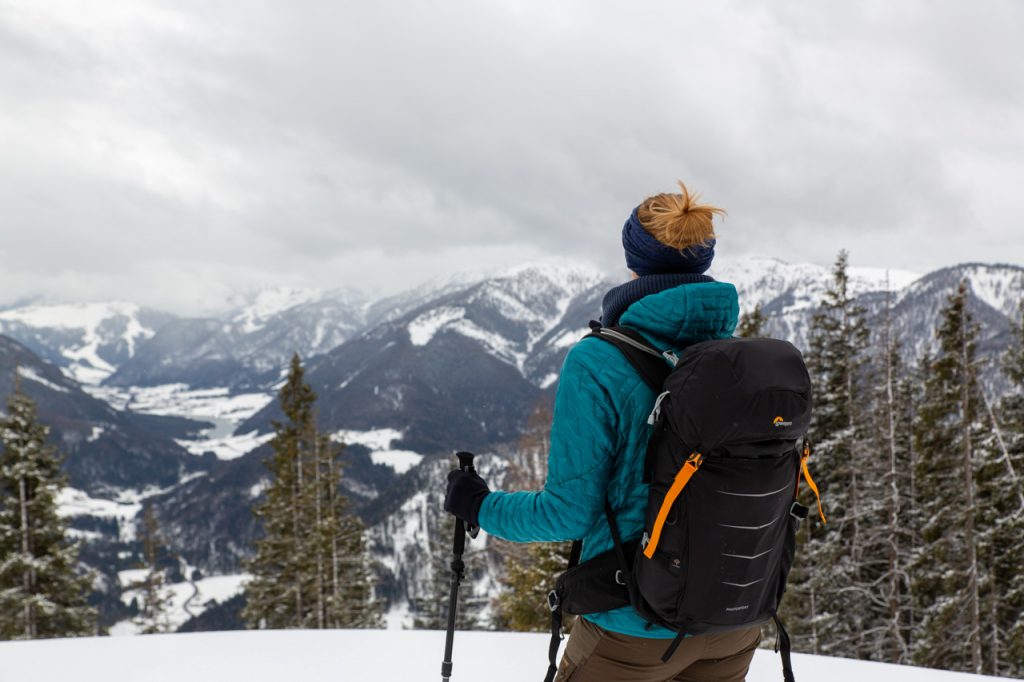
Necessary equipment for snowshoeing
#1 – Snowshoes
Snowshoes are most reminiscent of short, wide skis with spikes on the underside. They are made of hard plastic and are fastened to the winter boot using straps. Interest in snowshoeing has grown in the past few years. You can therefore often buy snowshoes at most major ski resorts and in well-stocked outdoor shops. The price varies by brand or model, but can be obtained from approx. 65$. Or you can rent snowshoes from approx. 12$ per day.
#2 – Boots
For snowshoes, it is recommended to use waterproof hiking boots that go up above the ankle and have a solid sole. Alternatively, you can also use waterproof winter boots. We used hiking boots lined with Gore-Tex (Salomon Quest 4D).
#3 – Gaters
If the trip goes off-piste or in deep snow, it is an advantage to use gaters. The short leggings block the snow so that it does not find its way into the boots. If you are wearing normal hiking trousers, the gaters also function as an extra warm layer.
#4 – Walking sticks
The walking poles are a must. In addition to relieving the knees and legs, they also make it easier to keep your balance in uneven snow. Attach wide baskets on the tips so that the poles grip the surface of the snow and do not punch through so easily.
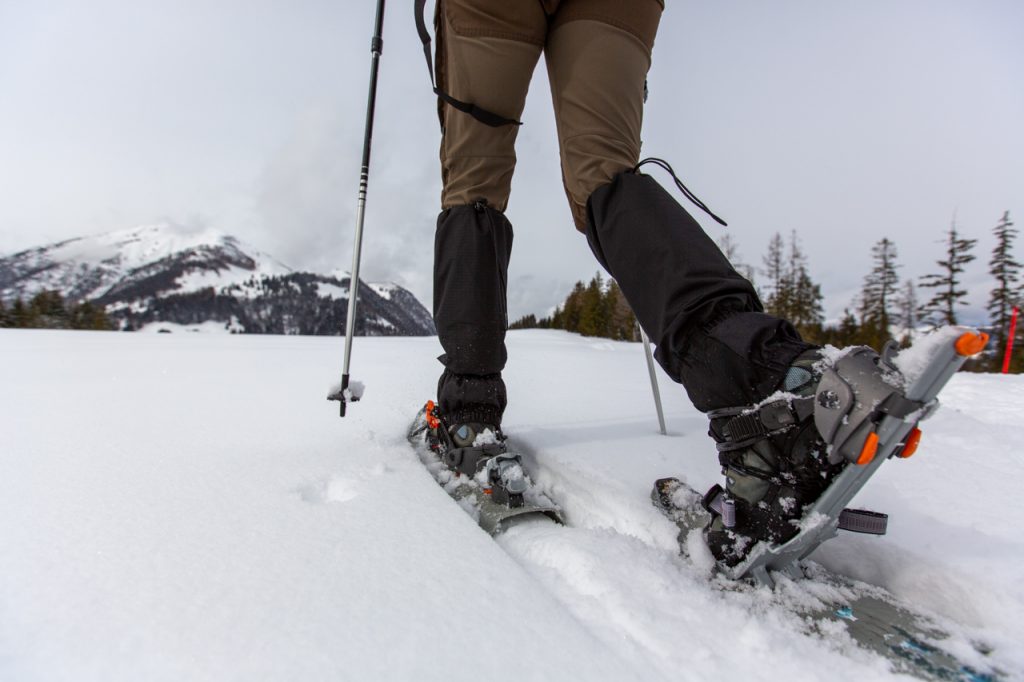
#5 – Winter clothes
Remember to dress in several layers so that you are prepared for changing weather conditions. A good tip is to use merino wool as the inner layer, as it functions both as a temperature regulator and sweat transporter. Also bring a good shell jacket that is rain and windproof, as well as headgear and gloves.
#6 – Buff
The stretchable neck tube takes up nothing in the rucksack and is brilliant as both a scarf, hat, and wrist warmers. If you are prone to freezing, you can get an extra thick Buff with fleece on the inside.
#7 – Backpack
It is a good idea to take a light daypack with you for a change of clothes. Also remember water, sunglasses, sunscreen, lip balm, and perhaps some energy-rich snacks if you plan more than a few hours of hiking.
#8 – Our favorite clothing
Besides long-sleeved merino wool undershirts, our favorite piece of clothing on the trip was a Patagonia Micro Puff jacket. The jacket is ultralight, but warm and windproof and kept dry in light snow.
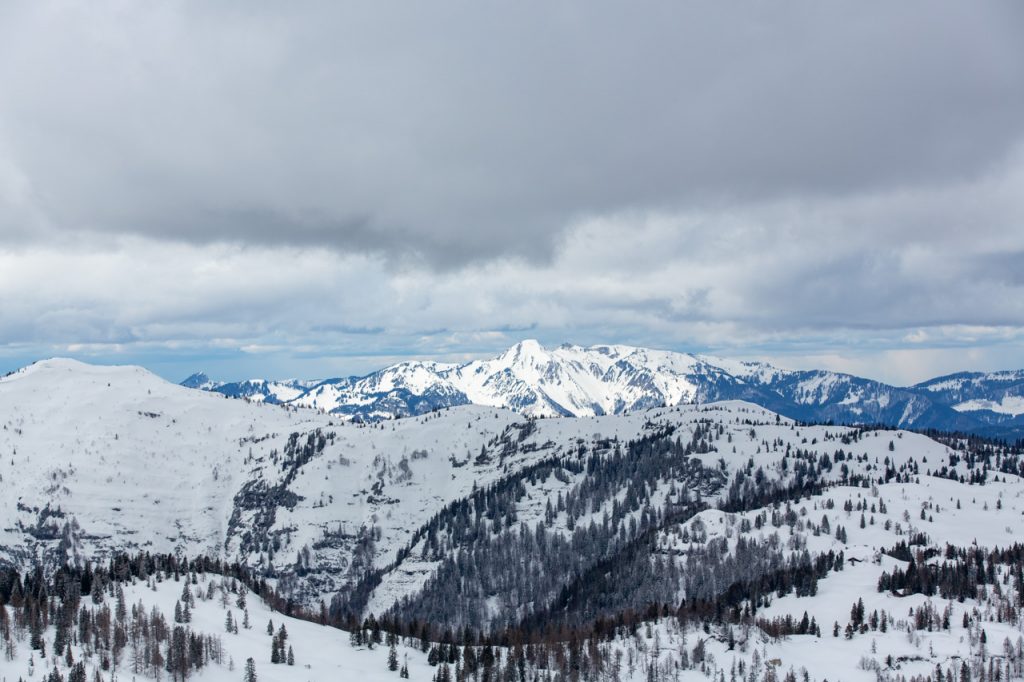
Good routes for snowshoeing
Snowshoeing in Austria
We hiked at Pillerseetal, Fieberbruun, and Steinplatte, which are part of the popular Kitzbühel Alps in Tyrol. Kitzbühel has four ski areas with a large network of pistes totaling 1,088 kilometers and many good hiking trails (which can be used in winter). You can use these as a starting point and hike on from there on your own. Read more about snowshoe hiking in the area on the website of The Austrian Tourist Board.
Choose your own route
It is clearly the most fun to go snowshoeing in high, pristine snow, and with snowshoes, you can hike pretty much anywhere. Be aware that you must not walk on slopes or on established ski tracks. Feel free to ask the locals where it is possible to hike before you set off.
Off-piste
Take a cable car up to a piste, and while the rest of the family is skiing, you can wander into the surrounding winter landscape. If you are hiking by a piste, you must walk on the edge so that you do not damage the prepared tracks.
Security
Do not venture out on your own or off the marked trails if you do not know the terrain. Under the meter-deep snow, streams, snow bridges, steep slopes and other things that you cannot see with the naked eye can be hidden. Consult the locals or go on an organized tour to be on the safe side.
Guided tours
Interest in snowshoe hiking has grown, so there are more opportunities to go on organized tours at the larger ski resorts. You can also go on a so-called snow safari, where the guide talks about flora and fauna and looks for traces of wildlife. We can recommend the guide Lisa Flatscher if you hike at Pillerseetal. Read more on her website.
With torches and toboggan
If you want to add a little extra adventure to your snowshoe hike, you can go on a guided tour with torches in the evening and have dinner under the stars. Or you can hike to the top of a sledding hill, strap your snowshoes on your backpack and sled down. The so-called toboggan runs in Austria are often a few kilometers long, and the toboggans are free to borrow.
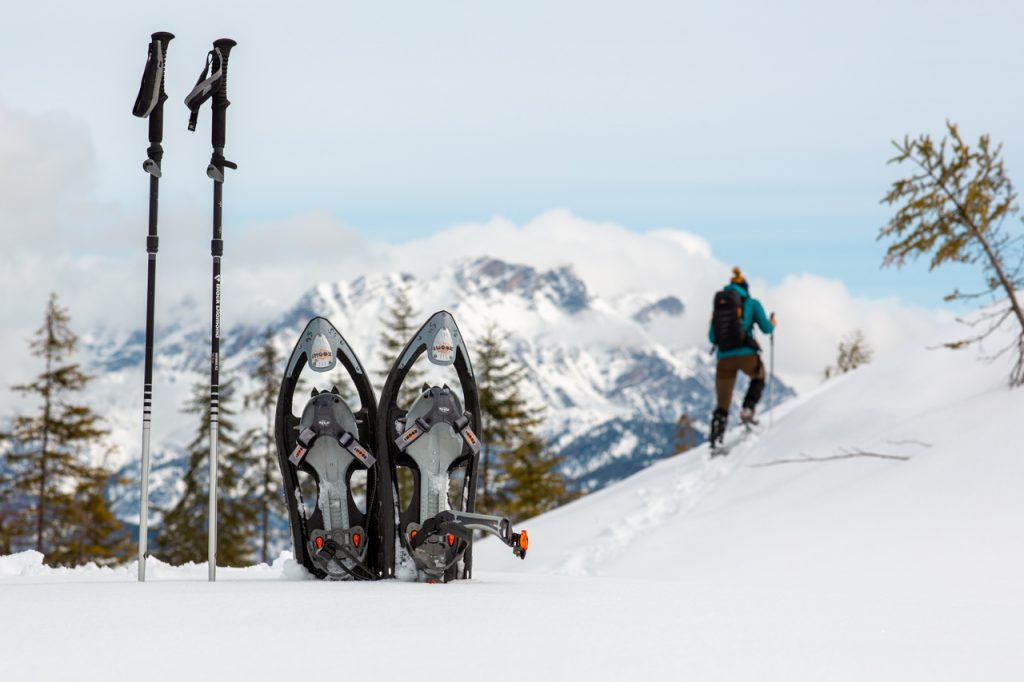
Travel info
Best time
The season for snowshoeing is in principle slightly longer than when you are on skis, as you can also hike in places where there is little or sporadic snow. However, the experience is much more fun when you hike in deep, creaking, and untouched snow.
Transportation
You can drive directly to the Kitzbüheler Alpen in Austria in approx. 13 hours from Copenhagen or fly to Munich, Innsbruck, or Salzburg, from where there are several different transport options. We flew from Copenhagen to Munich (1.5 hours) and drove a minibus round trip between the airport and the hotel (3 hours).
Accommondation
There is a sea of family-owned mountain huts and accommodation options at the Kitzbüheler Alpen. If you are looking for a place where you can combine an active winter holiday with wellness and half-board, we can recommend Sportresort Hohe Salve, located right next to the slopes in Hopfgarten.

